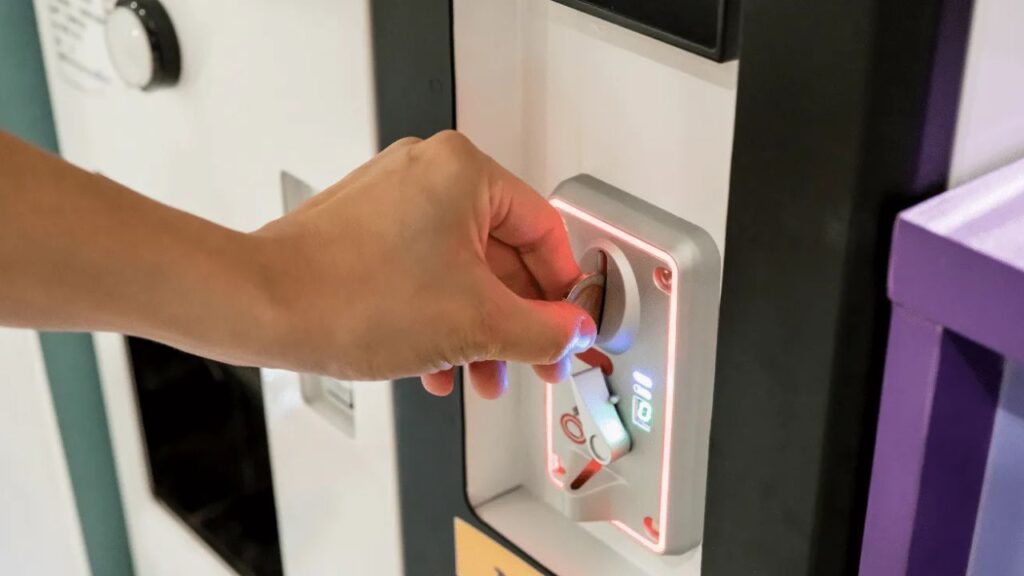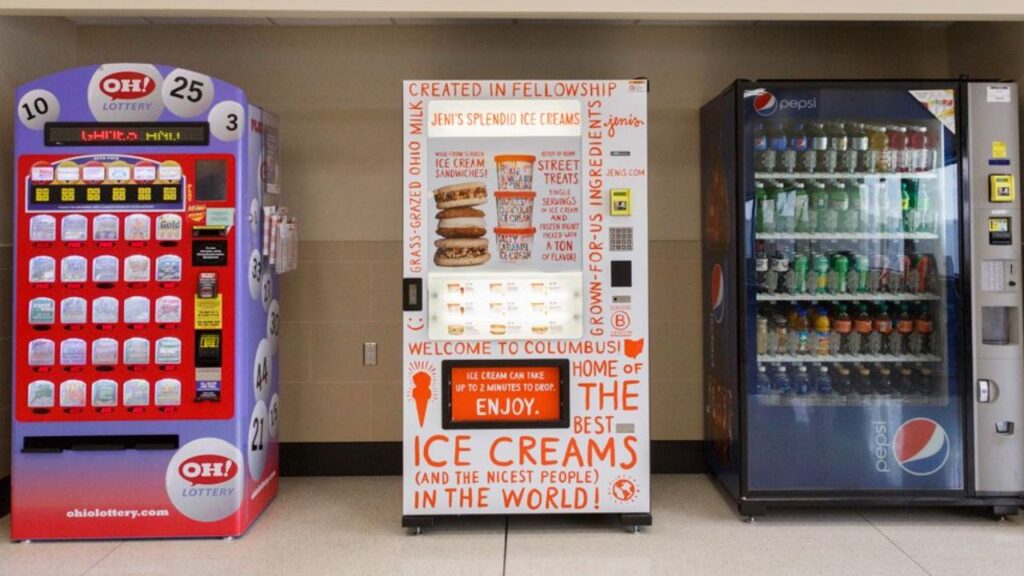Knowing how to break into a vending machine without a key requires intelligently navigating its mechanisms and security systems. By understanding the machine’s structure and vulnerabilities, one can use various methods such as coin mechanism manipulation, lock bypassing, and drilling to gain unauthorized access. This covert pursuit requires resources and caution to avoid legal repercussions and ethical dilemmas. Every step demands meticulous attention, from determining the type of lock to selecting the appropriate tool. However, it is essential to recognize the potential consequences and consider alternative solutions before attempting such actions. Ultimately, entering how to break into a vending machine without a key is a complex endeavor that requires both skill and discretion.
Vending Machine Mechanics
Vending machine mechanics entails grasping the intricate workings behind these automated devices. These machines rely on a combination of sensors, motors, and mechanisms to function. At their core, vending machines feature a coin mechanism, bill acceptor, product delivery system, and often a control board.
Coins or bills are validated by the acceptor, triggering the release of the selected product. Product dispensing involves several steps, including product selection, retrieval from the internal storage area, and delivery to the customer. Additionally, vending machines employ safety features to prevent theft or damage. Mastering these mechanics empowers individuals in maintaining, repairing, or even designing vending machines.

Identifying Vulnerable Access Points
Identifying vulnerable access points in vending machines involves recognizing potential weak spots where unauthorized access or tampering could occur. These points typically include the machine’s exterior panels, lock mechanisms, and service doors. Coin slots, bill acceptors, and product delivery compartments are also susceptible. Poorly secured keyholes or damaged locks may also present vulnerabilities.
How to Break into a Vending Machine without a Key, outdated software or firmware could pose security risks. Finding these weak places requires routine inspections and risk assessments. Strengthening security measures such as upgrading locks, implementing surveillance, or utilizing tamper-evident seals can mitigate these vulnerabilities, safeguarding vending machine operations and ensuring customer trust.
Assessing Different Lock Types
Assessing different lock types for vending machines involves considering various factors such as security, ease of use, and maintenance requirements. Traditional key locks offer simplicity but can be vulnerable to picking or duplication. Electronic locks provide higher security through keyless entry and audit trail capabilities but may require more maintenance.
Biometric locks offer advanced security using fingerprint or iris recognition but can be costly and face technical challenges. Combination locks provide flexibility and can be reset easily but may be prone to manipulation. Evaluating these options based on specific needs and budgets ensures optimal security measures for vending machine protection.
Coin Mechanism Manipulation Techniques
Coin mechanism manipulation techniques for vending machines encompass various methods to exploit vulnerabilities and illicitly acquire products. Techniques include using counterfeit or slugged coins, such as washers or tokens, to mimic valid currency. Stringing involves inserting a nylon thread attached to a coin, enabling repeated use.
Slug rejection exploits the mechanism’s inability to recognize certain metals, allowing for unauthorized refunds. Additionally, tilt or shake methods aim to trigger false positive readings for coin acceptance. Vending machine operators combat these manipulations by implementing advanced coin validators, regular maintenance checks, and security features such as tilt sensors or electromagnetic shielding to deter fraudulent activities.
Bypassing Traditional Locks
Bypassing traditional locks on vending machines involves exploiting weaknesses in the locking mechanisms to gain unauthorized access. Techniques such as lock picking, bump keys, or shim tools can manipulate tumblers or latch mechanisms without needing a key. Alternatively, drilling the lock or using brute force can compromise security but may damage the machine.
Lock bypass tools, like tension wrenches or lock bypass guns, expedite entry by manipulating internal components directly. Vending machine operators combat these threats by employing high-security locks, regular maintenance, and surveillance measures to deter and detect unauthorized access attempts, safeguarding machine contents and revenue.

Alternative Entry Methods
Exploring alternative entry methods for vending machines involves identifying unconventional ways to access their contents. Techniques may include exploiting structural weaknesses, such as removing panels or bypassing security seals, to gain entry without triggering alarms. Advanced methods involve utilizing specialized tools like lock bypass kits to circumvent traditional lock mechanisms.
Electronic manipulation techniques, like hacking into control systems or overriding security protocols, can also grant unauthorized access. Vending machine operators counter these threats through regular security audits, implementing tamper-resistant designs, and integrating advanced access control systems to thwart unauthorized entry attempts, ensuring the integrity and security of their machines and contents.
Making Use of Universal Keys
Universal keys for vending machines involve exploiting master key systems designed for maintenance and servicing. These keys, often available through unauthorized channels, give people access to various vending machines, bypassing individual locks. While convenient for authorized personnel, their widespread availability poses security risks.
Criminal elements can acquire or duplicate these keys to gain unauthorized access, leading to theft and vandalism. Vending machine operators combat this threat by limiting access to authorized personnel, implementing additional security measures such as electronic locks or tamper-proof seals, and regularly updating lock systems to deter exploitation of universal keys, safeguarding machine integrity and revenue.
Examining the Drilling Method
Examining the drilling method for vending machines entails understanding its role as a last-resort technique for gaining unauthorized access. By drilling directly into the locking mechanism, perpetrators can bypass traditional security measures, albeit at the expense of damaging the machine.
This method is typically employed when other avenues, such as lock-picking or bypassing, prove unsuccessful. However, drilling leaves obvious signs of tampering and requires subsequent repairs, which can be costly for vending machine operators. To mitigate this risk, operators often reinforce vulnerable areas, install tamper-resistant locks, and employ surveillance measures to deter and detect drilling attempts, preserving machine integrity and revenue.
The Inner Workings of Vending Machine Doors
Analyzing the inner workings of vending machine doors reveals a complex system designed to ensure security and functionality. These doors typically consist of multiple layers, including outer panels for aesthetics and protection, inner insulation for temperature control, and innermost compartments housing vital components such as the product dispensing mechanism, coin and bill acceptors, and control electronics.
How to Break into a Vending Machine without a Key, Understanding this intricate setup is crucial for maintenance and repair tasks. Additionally, recognizing potential vulnerabilities in door seals, hinges, and locking mechanisms allows operators to implement effective security measures, safeguarding the machine against unauthorized access, tampering, and theft, ensuring uninterrupted operation and customer satisfaction.
Disassembling Exterior Components
Disassembling exterior components of vending machines involves a meticulous process to access internal mechanisms for maintenance or repair. This typically entails removing outer panels, which can vary in complexity depending on the machine’s design. Careful attention must be paid to fasteners, hinges, and interlocking mechanisms to avoid damage during disassembly.
Once the exterior is removed, technicians access vital components such as the  product delivery system, coin and bill acceptors, and control electronics. Understanding this process allows efficient troubleshooting and servicing, ensuring optimal vending machine performance and customer satisfaction while minimizing downtime and maintenance costs.
product delivery system, coin and bill acceptors, and control electronics. Understanding this process allows efficient troubleshooting and servicing, ensuring optimal vending machine performance and customer satisfaction while minimizing downtime and maintenance costs.
Leveraging Specialized Tools for Entry
Leveraging specialized tools for entry into vending machines involves utilizing equipment designed to circumvent security measures and gain unauthorized access. These tools include lock picks, which manipulate tumblers to open traditional locks, and lock bypass kits, specifically engineered to exploit vulnerabilities in locking mechanisms.
Additionally, brute force tools like drills or pry bars may forcefully breach machine enclosures. While these methods can grant access, they often result in damage, compromising machine integrity and functionality. To mitigate risks, vending machine operators prioritize security upgrades, employ tamper-resistant locks, and conduct regular inspections to detect and deter unauthorized entry attempts, safeguarding machine contents and revenue.
Implementing Creative Solutions
Implementing creative solutions for access to vending machines involves devising alternative methods to address maintenance or servicing needs without compromising security. These solutions may include developing specialized access panels or removable sections, allowing technicians to reach internal components easily.
Moreover, electronic access systems with programmable codes or biometric authentication can streamline authorized entry while enhancing security. By fostering innovation in design and technology, vending machine operators can minimize disruption to service, reduce maintenance costs, and ensure the integrity of their machines. These creative approaches demonstrate a commitment to convenience and security, ultimately enhancing customer satisfaction and operational efficiency.
Overcoming Security Features
Overcoming security features for vending machines involves identifying and exploiting weaknesses in the system to gain unauthorized access. This may include bypassing traditional locks using lock-picking tools or manipulating electronic access controls through hacking techniques. Additionally, physical methods such as drilling or forcing entry can compromise machine integrity.
Vending machine operators must continually update security measures, incorporating advanced technologies like biometric authentication and tamper-resistant enclosures to deter unauthorized access attempts. Vigilant monitoring and prompt response to suspicious activities are essential in safeguarding machine contents and revenue. Operators can maintain customer trust and integrity by avoiding emerging threats.
Evaluating Risks and Legal Implications
Evaluating risks and legal implications for vending machines involves assessing potential threats to both security and compliance with relevant laws and regulations. Risks may include theft, vandalism, and unauthorized access, leading to financial losses and legal liabilities. Moreover, failure to adhere to standards regarding product safety, accessibility, and data protection can result in legal consequences.
To mitigate these risks effectively, vending machine operators must conduct thorough risk assessments, implement robust security measures, and stay abreast of evolving legal requirements. By prioritizing security and compliance, operators can safeguard their business interests, uphold consumer trust, and avoid costly legal disputes.
Practicing Discretion and Caution
Practicing discretion and caution with vending machines involves exercising careful judgment and adherence to safety protocols during operation, maintenance, and servicing tasks. Operators and technicians must handle sensitive components and access points cautiously to avoid damage or injury.
How to Break into a Vending Machine without a Key, discretion is crucial when dealing with security measures to prevent unauthorized access or tampering. Regular training on safe practices and security protocols is essential to ensure personnel competency and minimize risks. By fostering a culture of discretion and caution, vending machine operators uphold safety standards, protect machine integrity, and mitigate potential liabilities, ultimately ensuring the well-being of personnel and customers alike.
Conclusion
Although various techniques exist to circumvent keyless vending machines, it is illegal and unethical to engage in such activities. Attempting to exploit vulnerabilities in vending machines jeopardizes their integrity, compromises revenue streams, and can lead to legal consequences. Instead of focusing on unauthorized access, efforts should be directed toward enhancing security measures, implementing strong safeguards, and adhering to ethical business practices
.
How to break into a vending machine without a key, Vending machine operators should prioritize proactive maintenance, regular inspections, and employee training to prevent breaches and ensure the security of their assets. The vending industry can sustainably thrive by maintaining integrity and legitimacy while maintaining trust and accountability.
FAQ
What do I do if I Lose My Vending Machine Key?
Another advantage of calling a locksmith to help open a vending machine without a key is that they can replace the lock, saving you the trouble the next time you need to open the machine to restock or collect money.
Is there a Universal Key for Vending Machines?
Thus, vending machines would only be safe if there were a universal key for all. It follows that there is only a universal key for some vending machines.
Does every Vending Machine have a Master Key?
First, you should know that any device can only be unlocked using a limited number of universal keys. Vending machine keys are all keyed differently for security reasons. Only a key with a corresponding “key code” can open the locks on these computers.
How does Lock Bumping Work?
When bumping a lock, one inserts a bump key into the keyway until it is one notch (pin) shy of full insertion; at this point, the key is pushed farther into the keyway by bumping it inward. The bump key’s uniquely shaped teeth impact every key pin in the lock.
What are Intelligent Vending Machines?
A smart vending machine, also known as an IT vending machine, is a type of vending machine that is outfitted with sophisticated technology, including internet connectivity and software, enabling it to carry out sophisticated tasks like receiving multiple payment methods, offering real-time inventory updates, and gathering information on customer behavior.

